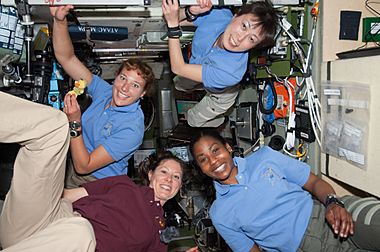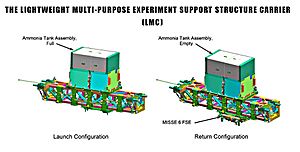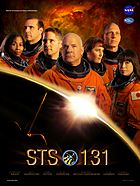STS-131 facts for kids
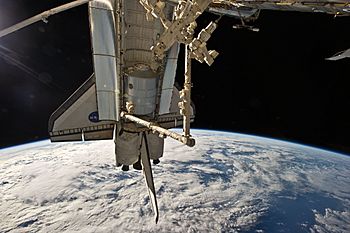
Canadarm2 grapples the MPLM Leonardo in Discovery's payload bay, prior to berthing
|
|
| Mission type | ISS logistics |
|---|---|
| Operator | NASA |
| Mission duration | 15 days 2 hours, 47 min, 11 seconds |
| Distance travelled | 10,029,810 kilometres (6,232,235 mi) |
| Orbits completed | 238 |
| Spacecraft properties | |
| Spacecraft | Space Shuttle Discovery |
| Launch mass | 2,051,031 kilograms (4,521,749 lb)(total) 121,047 kilograms (266,864 lb) (orbiter) |
| Landing mass | 102,039 kilograms (224,957 lb) |
| Crew | |
| Crew size | 7 |
| Members |
|
| Start of mission | |
| Launch date | 5 April 2010, 10:21:22 UTC |
| Launch site | Kennedy LC-39A |
| End of mission | |
| Landing date | 20 April 2010, 13:08:35 UTC |
| Landing site | Kennedy SLF Runway 15 |
| Orbital parameters | |
| Reference system | Geocentric |
| Regime | Low Earth |
| Perigee | 320 kilometres (200 mi) |
| Apogee | 346 kilometres (215 mi) |
| Inclination | 51.6 degrees |
| Period | 90 minutes |
| Docking with ISS | |
| Docking port | PMA-2 (Harmony forward) |
| Docking date | 7 April 2010, 07:44 UTC |
| Undocking date | 17 April 2010, 12:52 UTC |
| Time docked | 10 days, 5 hours, 8 minutes |
 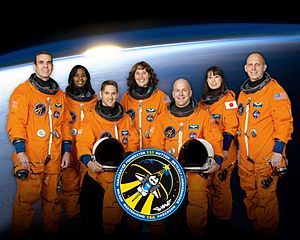 Seated: James Dutton (left) Alan Poindexter (right), Standing (l-r): Rick Mastracchio, Stephanie Wilson, Dorothy Metcalf-Lindenburger, Naoko Yamazaki (JAXA) and Clayton Anderson |
|
STS-131 was a NASA Space Shuttle mission to the International Space Station (ISS). It was also known as ISS assembly flight 19A. The Space Shuttle Discovery launched on April 5, 2010, from Launch Pad 39A. It landed on April 20, 2010, at the Kennedy Space Center's Shuttle Landing Facility. This mission was the longest flight for Space Shuttle Discovery.
The main cargo for STS-131 was a special container called a Multi-Purpose Logistics Module (MPLM). This module was packed with supplies and equipment for the International Space Station. During the mission, astronauts also replaced a large ammonia tank outside the station. STS-131 carried many different science experiments and tools. It was also the last shuttle mission to fly with a crew of seven astronauts.
Contents
- Meet the Astronauts: STS-131 Crew
- What Did Discovery Carry?
- STS-131: Important Moments
- Getting Ready for Launch
- Mission Journey: Day by Day
- Day 1: Launch into Space
- Day 2: Checking the Shuttle
- Day 3: Docking with the ISS
- Day 4: Unpacking Leonardo
- Day 5: Spacewalk 1
- Day 6: More Transfers and a False Alarm
- Day 7: Spacewalk 2
- Day 8: Rest and Interviews
- Day 9: Spacewalk 3
- Day 10: Final Transfers and Fun Time
- Day 11: Saying Goodbye to Leonardo
- Day 12: Final Shuttle Check
- Day 13: Undocking from the ISS
- Day 14: Getting Ready to Land
- Day 15: Landing Delay
- Day 16: Landing Day!
- Spacewalks: Working Outside the Station
- Wake-up Songs in Space
- See also
Meet the Astronauts: STS-131 Crew
| Position | Astronaut | |
|---|---|---|
| Commander | Alan Poindexter Second and last spaceflight |
|
| Pilot | James Dutton Only spaceflight |
|
| Mission Specialist 1 | Richard Mastracchio Third spaceflight |
|
| Mission Specialist 2 | Dorothy M. Metcalf-Lindenburger Only spaceflight |
|
| Mission Specialist 3 | Stephanie Wilson Third spaceflight |
|
| Mission Specialist 4 | Naoko Yamazaki, JAXA Only spaceflight |
|
| Mission Specialist 5 | Clayton Anderson Second and last spaceflight |
|
Cool Facts About This Crew:
|
||
What Did Discovery Carry?
Leonardo: The Space Delivery Module
The main cargo for STS-131 was the Leonardo Multi-Purpose Logistics Module (MPLM). Think of it as a giant moving van for space. Leonardo was filled with food, water, and science supplies for the International Space Station (ISS).
It also carried special equipment like:
- The third and last Minus Eighty Degree Laboratory Freezer for ISS (MELFI). This freezer keeps science samples super cold.
- The Window Orbital Research Facility (WORF). This is a special window for looking at Earth and doing experiments.
- A new Crew Quarters Rack, which is like a small bedroom for astronauts.
- The Muscle Atrophy Resistive Exercise (MARES) rack, for astronauts to exercise and keep their muscles strong.
- Other storage racks and platforms for supplies.
Ammonia Tank Carrier
The mission also brought a special carrier called the Lightweight Multi-Purpose Equipment Support Structure Carrier (LMC). This carrier held a new Ammonia Tank Assembly (ATA). Ammonia is used to cool the space station. The old, empty tank was brought back to Earth on the LMC.
TriDAR: A Smart Space Camera
This mission was the second test flight for the TriDAR. This is a special 3D camera that uses lasers. It helps spacecraft know exactly where they are and how they are moving. This is important for safely docking with other spacecraft. TriDAR can guide a vehicle without needing special markers on the target. It uses a 3D laser and a heat camera to see the shape of objects. This helps it figure out its position and direction in real-time. During STS-131, TriDAR watched the ISS as Discovery docked, undocked, and flew around it.
STS-131: Important Moments
This mission was special for many reasons:
- It was the 162nd time NASA sent humans into space.
- It was the 131st Space Shuttle mission since the first one, STS-1.
- It was the 38th flight for the Space Shuttle Discovery.
- It was the 33rd shuttle mission to visit the ISS.
- It was the 35th and final night launch of a space shuttle.
- It was the second time a shuttle entered Earth's atmosphere in a "descending node" since 2003.
Getting Ready for Launch
Space Shuttle Discovery was moved to the Vehicle Assembly Building (VAB) on February 22, 2010. This was done a day early to avoid bad weather. The VAB is where the shuttle is put together with its fuel tank and booster rockets.
The plan to move Discovery earlier was delayed because it was too cold at the Kennedy Space Center. The VAB needed to be warm enough to protect the shuttle's systems.
Discovery then began its slow journey to Launch Pad 39A on March 2, 2010. This trip is called the rollout. The entire shuttle stack, including the fuel tank and boosters, was secured at the launch pad on March 3. The 3.4-mile trip took almost 7 hours. The rollout was delayed by a day because of lightning warnings. Engineers also had to fix some damage to the External Tank (ET-135). Birds had pecked at the foam that protects the tank.
Mission Journey: Day by Day
Day 1: Launch into Space
Discovery launched successfully at 6:21 AM EDT on April 5. This was the last time a Space Shuttle launched at night. After an exciting 8.5-minute ride, the seven astronauts started getting Discovery ready for orbit. Commander Alan Poindexter and pilot Jim Dutton adjusted the shuttle's path towards the International Space Station.
The crew opened the payload bay doors and set up computers. However, the Ku-band antenna, which sends images and data to Earth, stopped working. This meant they couldn't send pictures of the external fuel tank right away. The crew had to check the shuttle's heat shield themselves. This antenna also helps measure the distance to the space station.
Day 2: Checking the Shuttle
On their first full day in space, the crew woke up early. Because the Ku-band antenna wasn't working, NASA sent new instructions for their day. Commander Poindexter and pilot Dutton used Discovery's engines to fine-tune their path to the ISS. Astronauts Naoko Yamazaki and Dorothy Metcalf-Lindenburger started checking the Canadarm, the shuttle's robotic arm.
Stephanie Wilson prepared equipment to record the inspection of the shuttle's heat shield. This video would be sent to Earth later. The whole crew then worked together to inspect the heat shield. Meanwhile, Rick Mastracchio and Clayton Anderson prepared the spacesuits for their spacewalks. The crew also got all the tools ready for docking with the ISS.
Day 3: Docking with the ISS
Space Shuttle Discovery successfully docked with the space station at 3:44 AM EDT on April 7, 2010. They were 220 miles above the Caribbean Sea. Before docking, Commander Poindexter flew Discovery in a special flip maneuver. This allowed the station crew to take over 350 photos of the shuttle's heat shield.
Once docked, the crews checked for leaks. The hatches between the two spacecraft opened earlier than planned, at 5:11 AM EDT. The STS-131 crew got a safety briefing from the station crew. They then started moving important items, including the two spacesuits for spacewalks. The station's robotic arm, Canadarm2, grabbed the shuttle's inspection boom. The shuttle crew also started sending all the inspection videos and launch images to Earth.
Day 4: Unpacking Leonardo
On Day 4, Stephanie Wilson and Naoko Yamazaki used the robotic arm to attach the Leonardo module to the station. It was connected at 12:24 AM EDT. The hatches to Leonardo were opened by station astronaut Soichi Noguchi and shuttle astronaut Clayton Anderson at 7:58 AM EDT. The astronauts then began moving cargo from Leonardo. The first item was a Rate Gyro Assembly, which would be replaced during a spacewalk.
Commander Alan Poindexter gave several interviews during the day. At the end of the day, Rick Mastracchio and Clayton Anderson went into the Quest airlock. They breathed pure oxygen as the air pressure was lowered. This "pre-breathe" helps prevent decompression sickness during spacewalks.
Day 5: Spacewalk 1
On Day 5, Rick Mastracchio and Clayton Anderson completed the first spacewalk. They released the new ammonia tank for later installation. They also removed an experiment from the Kibo Exposed Facility. They replaced a broken gyroscope, which helps the station navigate. The spacewalkers were helped by the station's robotic arm, operated by Jim Dutton and Stephanie Wilson.
While the spacewalk was happening, Naoko Yamazaki and Alan Poindexter moved large science racks from Leonardo to their new spots on the ISS.
Day 6: More Transfers and a False Alarm
Day 6 was all about moving supplies from Leonardo and the shuttle. The crew moved the Windows Observational Research Facility (WORF) to the Destiny lab. Naoko Yamazaki and Soichi Noguchi also moved Express Rack 7 (ER7).
In the morning, a smoke alarm went off in the Russian part of the station. The crew followed emergency procedures, but it turned out to be a false alarm. Work quickly went back to normal. Astronauts Clay Anderson, Rick Mastracchio, and Stephanie Wilson gave interviews. Alan Poindexter, Jim Dutton, and Dorothy Metcalf-Lindenburger spoke with students. At the end of the day, the crew reviewed plans for the second spacewalk. Clay Anderson and Rick Mastracchio then prepared for their "campout" in the airlock.
Day 7: Spacewalk 2
On Day 7, astronauts Clay Anderson and Rick Mastracchio performed their second spacewalk. They started 45 minutes early and spent 7 hours and 26 minutes outside the ISS. They removed the old Ammonia Tank Assembly (ATA) and installed the new one. They had a small problem with one bolt, but managed to tighten it.
The two spacewalkers helped guide the robotic arm to temporarily store the old ATA. The new ATA's electrical connections were made, but the fluid connections were saved for the third spacewalk. Mastracchio and Anderson also installed two radiator grapple fixture stowage beams. Inside, the rest of the crew continued moving items from Discovery and Leonardo. About half of the transfer work was now done.
Day 8: Rest and Interviews
The astronauts had the morning off on Day 8. After their break, they continued moving cargo, which was now over 70% complete. The crews also had several video calls with important people and students from different countries. Alan Poindexter, Jim Dutton, Dorothy Metcalf-Lindenburger, and Stephanie Wilson also spoke with American news outlets.
While these calls were happening, Rick Mastracchio and Clay Anderson prepared their spacesuits and tools for the third and final spacewalk. They reviewed the procedures with the other crew members. After the review, they went into the airlock, lowered the pressure, and breathed pure oxygen for their "campout."
Day 9: Spacewalk 3
On Day 9, Rick Mastracchio and Clay Anderson completed the third and final spacewalk. It lasted 6 hours and 24 minutes. Their tasks included connecting the ammonia and nitrogen lines to the new Ammonia Tank Assembly (ATA). They also installed the old ATA into the shuttle's cargo bay to bring it back to Earth.
They also collected some shields that protect against tiny space debris. They attached a grapple bar to the new ATA and prepared some cables and tools for the next shuttle mission, STS-132. While the spacewalk was happening, Alan Poindexter and Naoko Yamazaki continued moving items from Leonardo to the ISS. Over 75% of the cargo transfers were now complete.
Day 10: Final Transfers and Fun Time
On the morning of Day 10, the STS-131 crew continued moving items. Most of the morning was spent transferring things back into the Leonardo module. Only a few items were left to move to Discovery's mid-deck. The entire crew enjoyed a long lunch together.
After lunch, all the astronauts from both the shuttle and station crews took a group photo. This was followed by a news conference with reporters from the U.S., Russia, and Japan. Later, Alan Poindexter, Dorothy Metcalf-Lindenburger, Stephanie Wilson, and Clayton Anderson spoke with students. The rest of the afternoon was free time for the crew.
Day 11: Saying Goodbye to Leonardo
On Day 11, the hatches to the Leonardo module were closed at 3:38 AM EDT. The module was then detached from the Harmony node of the ISS at 4:24 PM EDT. It was held just a few feet above Discovery's cargo bay. This was because a pin in the docking mechanism got stuck, causing a delay. The crew would finish putting Leonardo into the payload bay on Day 12. The crews also continued moving items between the ISS and the shuttle. About 94% of all cargo transfers were now complete.
Day 12: Final Shuttle Check
On Day 12, the crew secured the Leonardo module in Discoverys cargo bay for its return to Earth. Dorothy Metcalf-Lindenburger activated the latches to hold Leonardo in place at 3:15 AM EDT. After Leonardo was secured, Metcalf-Lindenburger and Jim Dutton began the final inspection of Discoverys heat shield. Alan Poindexter and Naoko Yamazaki joined them. They checked the heat-resistant panels on the wings and nose. This scan usually takes 7 hours, but they finished it 3 hours early. They did this while still docked to the ISS because the shuttle's Ku-Band antenna was still not working.
Day 13: Undocking from the ISS
Space Shuttle Discovery successfully undocked from the International Space Station at 8:52 AM EDT. Discovery had been docked to the ISS for 10 days, 5 hours, and 8 minutes. After undocking, pilot Jim Dutton flew the shuttle around the space station. Before undocking, the shuttle and station commanders said their goodbyes.
After undocking, the shuttle crew put away the Orbiter Boom Sensor System (OBSS) and the Shuttle Remote Manipulator System (SRMS). These robotic arms were no longer needed for the rest of the flight. The crew also received good news: Discovery's heat shield was cleared for re-entry into Earth's atmosphere.
Day 14: Getting Ready to Land
On Day 14, the crew of Space Shuttle Discovery started getting ready for landing. They packed and put away items they wouldn't need anymore. Commander Alan Poindexter and pilot Jim Dutton checked all the flight systems. This included testing the steering jets and flight controls. They also checked communications with ground stations. The crew took time to do interviews with news organizations.
Day 15: Landing Delay
The crew woke up on Day 15 and began preparing to return to Earth. This included closing the cargo bay doors and getting into their special orange landing suits. They were about to start drinking extra fluids to help their bodies adjust to gravity again. However, they were told that their first landing chance was canceled due to bad weather at the Kennedy Space Center. They waited to see if they could land on the second try, but that was also canceled because of the weather. The crew then began to put away their landing preparations.
Day 16: Landing Day!
Space Shuttle Discovery landed safely at 9:08 AM EDT (1:08 PM UTC) on runway 33 at Florida's Kennedy Space Center. This marked the end of their two-week mission in space.
Spacewalks: Working Outside the Station
Astronauts performed three spacewalks during this mission. Their main goals were to move and replace the ammonia tank and do other important tasks outside the station.
| Spacewalk Number | Spacewalkers | Start Time (UTC) | End Time (UTC) | How Long It Took |
|---|---|---|---|---|
| Spacewalk 1 | Rick Mastracchio Clayton Anderson |
April 9, 2010 05:31 |
April 9, 2010 11:58 |
6 hours 27 minutes |
| The crew inside used the station's robotic arm to take a new ammonia tank from the shuttle's cargo bay. They temporarily stored it on the station. The spacewalkers then got a seed experiment from outside the Japanese lab. They installed a grapple bar on the new ammonia tank and replaced a broken gyroscope, which helps the station navigate. They also did other small tasks. | ||||
| Spacewalk 2 | Mastracchio Anderson |
April 11, 2010 05:30 |
April 11, 2010 12:56 |
7 hours 26 minutes |
| The astronauts, with help from the station's arm, removed an empty ammonia tank from the station's structure. They temporarily stored it on a cart. The new tank was then installed, and its electrical connections were made. The old tank was temporarily stored on another part of the station until the third spacewalk. | ||||
| Spacewalk 3 | Mastracchio Anderson |
April 13, 2010 06:14 |
April 13, 2010 12:36 |
6 hours 24 minutes |
| Using the station's arm, the crew moved the old tank into the shuttle's cargo bay to bring it back to Earth. The spacewalkers also took a grapple bar from the old ammonia tank and put it on the new one. They moved some foot restraints and tools. They also prepared some cables for the next mission, STS-132. | ||||
Wake-up Songs in Space
NASA has a tradition of playing music to wake up astronauts. This started during the Gemini program. Each song is chosen specially, often by the astronauts' families. The songs usually have a special meaning to an astronaut or relate to their daily tasks.
| Flight Day | Song | Artist | Played for | Links |
|---|---|---|---|---|
| Day 2 | "Find Us Faithful" | Steve Green | Clay Anderson | WAV, MP3 TRANSCRIPT |
| Day 3 | "I Will Rise" | Chris Tomlin | Jim Dutton | WAV, MP3 TRANSCRIPT |
| Day 4 | "Hato to Shōnen" (The Pigeons and a Boy) | Joe Hisaishi | Naoko Yamazaki | WAV, MP3 TRANSCRIPT |
| Day 5 | "Defying Gravity" | Idina Menzel & Kristin Chenoweth | Dorothy Metcalf-Lindenburger | WAV, MP3 TRANSCRIPT |
| Day 6 | "We Weren't Born to Follow" | Bon Jovi | Rick Mastracchio | WAV, MP3 TRANSCRIPT |
| Day 7 | "Stairway To The Stars" | Ella Fitzgerald | Stephanie Wilson | WAV, MP3 TRANSCRIPT |
| Day 8 | "Because We Believe" | Andrea Bocelli | Alan Poindexter | WAV, MP3 TRANSCRIPT |
| Day 9 | "Galileo" | Indigo Girls | Dorothy Metcalf-Lindenburger | WAV, MP3 TRANSCRIPT |
| Day 10 | "The Miracle of Flight" | Mike Hyden | Clay Anderson | WAV, MP3 TRANSCRIPT |
| Day 11 | "The Earth in the Color of Lapis Lazuli" | Seiko Matsuda | Naoko Yamazaki | WAV, MP3 TRANSCRIPT |
| Day 12 | Opening theme to Stargate SG-1 | Joel Goldsmith | Rick Mastracchio | WAV, MP3 TRANSCRIPT |
| Day 13 | "Joy" | Newsboys | Jim Dutton | WAV, MP3 TRANSCRIPT |
| Day 14 | "What A Wonderful World" | Louis Armstrong | Stephanie Wilson | WAV, MP3 TRANSCRIPT |
| Day 15 | "Star Spangled Banner" | Alan Poindexter | WAV, MP3 TRANSCRIPT |
|
| Day 16 | "On The Road Again" | Willie Nelson | The entire crew | WAV, MP3 TRANSCRIPT |
See also
 In Spanish: STS-131 para niños
In Spanish: STS-131 para niños


